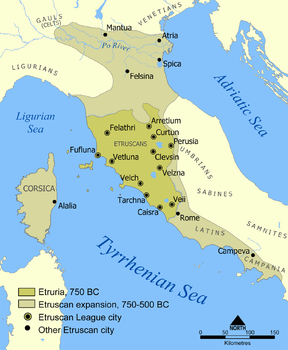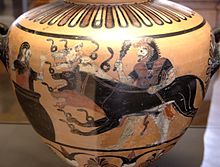Caere
Caere (also Caisra and Cisra) is the Latin name given by the Romans to one of the larger cities of southern Etruria, the modern Cerveteri, approximately 50–60 kilometres north-northwest of Rome.
[1] Caere was one of the most important and populous Etruscan city-states, in area 15 times larger than today's town, and only Tarquinia was equal in power at its height around 600 BC.
[4] The earliest evidence of settlement of the site comes from finds of urns at two areas (Cava della Pozzolana and Sorbo) from the 9th and 8th centuries BC.
At the height of its prosperity in the 6th century BC, the people of Caere (with the Carthaginians) emerged marginally victorious from clashes with the Phocaean Greeks.
Caere appears for the first time in documented history in 540 BC concerning the Battle of Alalia in which captured prisoners were stoned to death in the city, an act that was later attributed as the cause of an ensuing plague.
In 509 BC, upon the overthrow of the Roman monarchy, the king Lucius Tarquinius Superbus and his two eldest sons Titus and Aruns went into exile in Caere.
[8] In spite of the difficulties affecting Etruria during the period, trade once again flourished through the 5th century BC, arguably due to the particularly good relations with the Rome, a traditional ally of the city.
[9] Caere was not spared by the crisis that affected the great centres of southern Etruria during the second half of that century, after the defeat at sea at the Battle of Cumae in 474 BC.
[11] In 353 BC Caere, allied to the Tarquinii, lost a war with Rome and with it some of its territory, including the coastal area and ports so important for trade.
[13] During the period 700-300 BC the inhabitants constructed an impressive necropolis known today as Banditaccia, which is still not fully excavated but has already yielded the "Sarcophagus of the Spouses".



